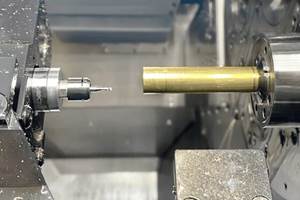Okuma America Introduces Next-Generation CNC Lathe
Machine tool builder Okuma America Corporation has introduced a new CNC lathe to address the growing need for a family of products suited to the needs of both first-time CNC users as well as experienced manufacturers supplying diverse industries with precision turned parts. Designated the Crown, Okuma's lathe offers a high-torque spindle motor, direct-drive headstock, servo-driven tool turret, an ergonomically-configured machine enclosure, and a compact 95. 47 by 69.
Share


Hwacheon Machinery America, Inc.
Featured Content
View More

Takumi USA
Featured Content
View More

.png;maxWidth=45)
DMG MORI - Cincinnati
Featured Content
View MoreMachine tool builder Okuma America Corporation has introduced a new CNC lathe to address the growing need for a family of products suited to the needs of both first-time CNC users as well as experienced manufacturers supplying diverse industries with precision turned parts. Designated the Crown, Okuma's lathe offers a high-torque spindle motor, direct-drive headstock, servo-driven tool turret, an ergonomically-configured machine enclosure, and a compact 95.47 by 69.4 inch machine footprint.
The new lathe is currently available in three models, the 10 hp Crown-E, the 15 hp Standard Bore, and 20 hp Big Bore. A V12 hydraulic turret is standard with the Crown-E. The Standard Bore and Big Bore models both use a V12 numerically controlled servomotor turret. Okuma engineers note that the new lathe is intended to be what they describe as "an evolutionary" product driven by the demands of end-users and the worldwide machine tool marketplace. Okuma officials project the production life-cycle of the Crown family at some 10,000 units through the year 2005.
Okuma America president John Hendrick explained, "We began production of the Crown this past April, initially producing some 40 units which comprise the first shipments to our Okuma distributor locations throughout North and South America. These first lathes began shipping from our Charlotte plant in June, with production reaching 60 units a month by July and up to 80 units monthly as early as next year.
The E-Series Crown offers entry-level CNC pricing, based on a hydraulic turret system that provides station-to-station tool index times of 0.8 seconds. The S-Type Crown, with its servo-driven turret, cuts tool index times to 0.2 seconds. Depending upon the model selected, main spindle speeds are infinitely variable between either 75 and 4200 rpm or 65 and 3500 rpm. Machine travels in the Z and X axes are the same for all models: X-axis, 7.28 inches; Z-axis, 20.47 inches; X-axis rapid feed rate, 590.55 ipm; and Z-axis, 787.4 ipm.
Okuma design engineers stress that the Crown is designed to facilitate production and simplify CNC turning operations. For example, the Crown's unusual, rounded enclosure helps deflect fluids and chips away from the workpiece, while it facilitates operator access for routine set up and parts removal operations. The lathe's Okuma-manufactured OSP CNC system pivots 90 degrees from the machine for convenient viewing during programming operations. According to the builder, the on-board MacMan system streamlines diagnostic procedures to cut troubleshooting time, while the OSP's integral floppy disk drive enables operators to quickly load custom CNC machining programs authored on a conventional PC.
Prospective Crown customers currently range from entry-level CNC users to multinational automotive manufacturers and their first-tier suppliers. Mr. Hendrick adds, "With Okuma's 1996 introduction of the CADET-Mate and CADET-V machining centers and this year's CTV-30 and CTV-40 vertical machining centers, in combination with its CNC grinder line, the new Crown lathe further positions the company to market a complete line of advanced machine tools with the commonality of OSP computer numerical control.
Okuma America Corporation is the U.S. affiliate of Okuma Corporation, a worldwide machine tool builder founded in Nagoya, Japan, in 1898. Established in Long Island, New York, in 1984, Okuma American today has a 364,000 square foot headquarters, manufacturing and training facility in Charlotte, North Carolina, employing 400 persons.
Related Content
Quick-Change Tool Heads Reduce Setup on Swiss-Type Turning Centers
This new quick-change tooling system enables shops to get more production from their Swiss turning centers through reduced tool setup time and matches the performance of a solid tool.
Read More3 Tips to Accelerate Production on Swiss Lathes with Micro Tools
Low RPM lathes can cause tool breakage and prevent you from achieving proper SFM, but live tooling can provide an economical solution for these problems that can accelerate production.
Read MoreSwiss-Type, Live Tooling Lathes Help Turn Company Around
New leadership’s investment in Swiss-type and live tooling lathes has enabled Rathburn Tool & Manufacturing to expand into new markets, reversing the company’s sluggish growth.
Read MoreIndustry Analysis: Machining Semiconductor Components
With many machine shops anticipating long-term growth in demand from the semiconductor industry, it is worth the time to heed the advice of manufacturers who have already been servicing this end-market for years.
Read MoreRead Next
Registration Now Open for the Precision Machining Technology Show (PMTS) 2025
The precision machining industry’s premier event returns to Cleveland, OH, April 1-3.
Read MoreBuilding Out a Foundation for Student Machinists
Autodesk and Haas have teamed up to produce an introductory course for students that covers the basics of CAD, CAM and CNC while providing them with a portfolio part.
Read More5 Rules of Thumb for Buying CNC Machine Tools
Use these tips to carefully plan your machine tool purchases and to avoid regretting your decision later.
Read More

































.jpg;maxWidth=300;quality=90)















